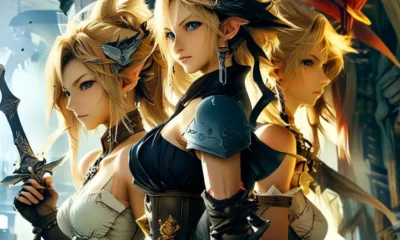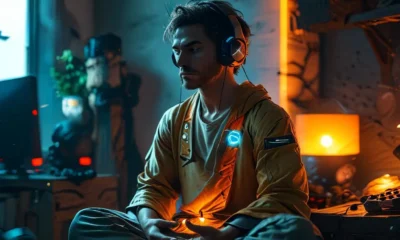Features
‘Life is Strange 2’ Episode 4 Review – “Faith”: A Journey Through Trump’s America
Life is Strange 2 continues its strong trajectory from the previous episode, weaving a complex and troubling tale of faith gone mad.
Life is Strange 2 has returned for its penultimate episode, a dense and troubling exploration of faith, prejudice and family in a time and place that has rarely been so divided: modern America. Following the events of Life is Strange 2‘s stellar third entry, Episode 4: “Faith” sees Sean attempting to pick up the pieces of his shattered life after Daniel’s violent outburst at Merrill’s farm.
Though the story of “Faith” begins in a hospital, with Sean working to recover from his injuries, the trajectory of the tale explores more settings and environments than any previous episode of the series. From wandering the highways of Nevada, to exploring a dusty motel, to sneaking into a remote church, Life is Strange 2‘s 4th entry never lacks for something new to see, or someone new to interact with.
However, the cynical bent of the story is the new centerpiece of Episode 4. Though Life is Strange 2 has never sidestepped the controversy and division of Trump’s America, “Faith” leans into these ideas with renewed fervor. Violence is committed more than once against our Mexican protagonist, and his skin color often sees him at odds with the more conservative denizens of the highways he journeys down. In a particularly telling exchange, Sean even finds himself beaten and placed on the other side of a closed compound, with a gun-toting guard glaring at him from the other side. Metaphors don’t really get much clearer than that.
This will, no doubt, lead to more calls of keeping politics out of games and other entertainment by the president’s more ardent supporters, but as other writers have pointed out, gaming has never been apolitical. Further, it would be categorically irresponsible to tell a story like this without addressing the elephant in the room. With these elements in mind, the politics of Life is Strange 2 have never been clearer than in Episode 4: “Faith”, and they account for some of the strongest storytelling fuel the series has found yet.
Politics aside, Life is Strange 2 also puts Sean at a variety of other disadvantages. His starting injuries include a lost eye that must be tended to medically throughout the episode, and the various beatings he takes throughout Episode 4 more than leave their mark. This leaves Faith as the typical darkest, and most troubling, episode of this second series, where we find our protagonist at his absolute lowest point, and must continue on with him in hopes of finding a better future. It’s a common enough trope, but one that is used to great effect here.
There are many returns of characters from previous episodes, some through letters and other communications, and others through surprising reveals and revelations. A particularly shocking character joins the story with zero preamble, and emerges as one of Life is Strange 2‘s finest editions yet. To spoil who, or how, would be criminal, but rest assured that Episode 4 is more full of surprises than any of the previous entries.
Though the main conflict that eventually reveals itself, that of Daniel being used as a messianic figure for an isolated Nevada church, feels contrived initially, the layers that are eventually revealed, and Daniel’s reason for joining the church, make a lot of sense in the overall scheme of things. Due to this strength of narrative, it really feels like all bets are off during the climax of Life is Strange 2: Episode 4, and that’s a good thing for a game so centered around the notion of interactive storytelling.
Fresh, prescient, and altogether rewarding, Life is Strange 2: Episode 4 — “Faith”, is a welcome piece of fiction in a society that has become so increasingly fragmented. It illustrates some of the horrors of the modern American landscape, but always remembers to remind us that there are good people out there, even when hope has never seemed so far away.

-

 Culture4 weeks ago
Culture4 weeks agoMultiplayer Online Gaming Communities Connect Players Across International Borders
-

 Features4 weeks ago
Features4 weeks ago“Even if it’s used a little, it’s fine”: Demon Slayer Star Shrugs Off AI Threat
-

 Features2 weeks ago
Features2 weeks agoBest Cross-Platform Games for PC, PS5, Xbox, and Switch
-

 Features2 weeks ago
Features2 weeks agoThe End Is Near! Demon Slayer’s Final Arc Trailer Hints at a Battle of Legends
-

 Features4 days ago
Features4 days agoPopular Webtoon Wind Breaker Accused of Plagiarism, Fans Can’t Believe It!
-

 Features3 weeks ago
Features3 weeks ago8 Video Games That Gradually Get Harder
-

 Features3 weeks ago
Features3 weeks agoDon’t Miss This: Tokyo Revengers’ ‘Three Titans’ Arc Is What Fans Have Waited For!
-

 Game Reviews2 weeks ago
Game Reviews2 weeks agoFinal Fantasy VII Rebirth Review: A Worthy Successor?
-

 Guides3 weeks ago
Guides3 weeks agoHow to buy games on Steam without a credit card
-

 Uncategorized3 weeks ago
Uncategorized3 weeks agoSleep Meditation Music: The Key to Unwinding
-

 Guides4 weeks ago
Guides4 weeks agoBest CSGO Sites with Free Bonuses
-

 Features7 days ago
Features7 days agoThe 9 easiest games of all time
























